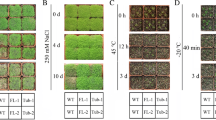Abstract
As a usual response, plants induce/activate various proteins which are thought to be involved in defense mechanisms against the biotic and abiotic stresses they may be confronted with. The novel DUF538 domain containing proteins with unknown functions have been found to be induced/activated in response to different environmental stress stimuli in plants. In order to perform biochemical studies with these new plant stress-responsive proteins, a cDNA containing DUF538 domain was amplified from Celosia cristata full-length leaf expression library using a specific primer set. The isolated cDNA was subsequently expressed in Escherichia coli as a part of maltose-binding fusion protein (MBP-DUF538 construct) and purified at the yield of about 32 mg per liter of cell culture by affinity chromatography without affecting the recombinant bacterial cell growth. The purified fusion product was exogenously applied (10 μg per 4 cm2) on the leaves of Nicotiana tobaccum L. The results revealed that fused DUF538 protein does not induce morphological reposes, but elevates redox enzyme activities including catalase, peroxidase, polyphenol oxidase and phenyalanine ammonia lyase. This is the first time ever time report with respect to the heterologous expression of a plant stress-responsive DUF538 domain that may provide a basis to study its physiological roles and biochemical activities in vitro and in vivo.






Similar content being viewed by others
Abbreviations
- MBP:
-
Maltose-binding protein
- DUF:
-
Protein of unknown function
- pfu:
-
Plaque formation unit
- IPTG:
-
Isopropyl-1-thio-ß-D-galactoside
- EDTA:
-
Ethylene diamine tetra-acetic acid
- OD:
-
Optical density
- PVP:
-
Polyvinyl polypyrrolidone
- PAL:
-
Phenylalanine ammonia lyase
References
Ausubel FM, Brent R, Kingston RE, Moore DD, Seiolman JG, Smith JA, Struhi R (eds) (1992) Current protocols in molecular biology. John Wiley & Sons, New York
Barnett T, Altschuler M, McDaniel CN, Mascarenhas JP (1980) Dev Genet 1:331–340
Basra AS (ed) (1994) Stress-induced gene expression in plants. Harwood Academic Publishers, Switzerland
Byrne P, Ward S, Harrington J, Fuller L (2004) Transgenic crops: an international and resource guide. http://WWW.colostate.edu/ transgenic crops
Calvete JS, Wieringa-Brants DH (1981) Eur J Plant Pathol 87:211–216
Dhaliwal HS, Kawai M, Uchimiya H (1998) Plant Biotechnol 15:1–10
Duplay P, Bedouelle H, Fowler A, Zabin I, Saurin W, Hofnung M (1984) J Biol Chem 259:10606–10613
Gholizadeh A, Baghbankohnehrouz B (2009) Biochemistry (MOSCOW) 74:137–144
Gholizadeh A, Baghbankohnehrouz B (2009) Indian J Exp Biol 47:684–689
Gholizadeh A, Baghbankohnehrouz B (2010) Russ J Plant Physiol 57:247–252
Gholizadeh A, Santha IM, Baghbankohnehrouz B, Lodha ML, Kapoor HC (2005) Biotechnol Appl Biochem 42:197–204
Grover A, Pental D (2003) Curr Sci 48:252–254
Hirt H, Shinozaki K (2003) Plant responses to abiotic stress (Topics in current genetics). Springer, Berlin and Heidelberg
Huber DJ, Nevins DJ (1981) Physiol Plant 53:533–539
Kellerman OK, Ferenci T (1982) Methods Enzymol 90:459–463
Laemmli UK (1970) Nature 227:680–685
Laidlaw WMR (1986) Ann Appl Biol 108:309–318
Nakagami H, Sugiyama N, Mochida K, Daudi A, Yoshida Y, Toyoda T, Tomita M, Ishihama Y, Shirasu K (2010) Plant Physiol 153:1161–1174
Rabbani MA, Maruyama K, Abe H, Khan MA, Katsura K, Ito Y, Yoshiwara K, Seki M, Shmozaki K, Yamaguchi-Shinozaki K (2003) Plant Physiol 133:1755–1767
Sadasivam S, Manickam A (1992) Biochemical methods for agricultural science. Wiley Eastern Limited, New Delhi
Siddiqe M, Cash JN, Sinha NK (1992) J Food Sci 57:1177–1183
Spitsin S, Steplewski K, Fleysh N, Belanger H, Mikheeva T, Shivprasad S, Dawson W, Kosprowski H, Yusibov V (1999) Proc Natl Acad Sci USA 96:2549–2553
Xiong L, Schumaker KS, Zhu JK (2002) Plant Cell 145:165–183
Xiong L, Zhu JK (2001) Physiol Plant 112:152–166
Zhang JZ, Creelman RA, Zhu JK (2004) Plant Physiol 135:615–621
Acknowledgments
The author of this paper is thankful to Research Institute for Fundamental Sciences (RIFS), University of Tabriz, Iran for supporting this work. The author also thanks Department of Biochemistry at PUSA Institue, New Delhi, India for providing the Celosia seeds.
Author information
Authors and Affiliations
Corresponding author
Rights and permissions
About this article
Cite this article
Gholizadeh, A. Heterologous Expression of Stress-Responsive DUF538 Domain Containing Protein and its Morpho-Biochemical Consequences. Protein J 30, 351–358 (2011). https://doi.org/10.1007/s10930-011-9338-9
Published:
Issue Date:
DOI: https://doi.org/10.1007/s10930-011-9338-9




